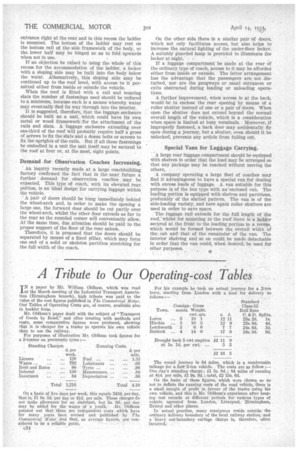A Tribute to Our Operating-cost Tables
Page 56

If you've noticed an error in this article please click here to report it so we can fix it.
INa paper by Mr. William Oldham, which was read at the March meeting of the Industrial Transport Association (Birmingham branch), high tribute was paid to the value of the cost figures published in The Commercial Motor. Out Tables of Operating Costs are, of course, available also in booklet form.
Mr. Oldham's paper dealt with the subject of "Transport of Goods by Road," and after treating with methods and coats, some comparative figures were produced, showing that it is cheaper for a trader to operate his own vehicle than to use the railway.
For purposes of illustration Mr. Oldham took figures for a 2-tonner on pneumatic tyres:— On a basis of five days per week, this equals 243d. per day, that is, 11 Os. ad. per day or 4id. per mile. These charges do not make allowance for an assistant, but 5s. 6d.. per day may be added for the wages qf a youth. .Mr. Oldham pointed out that ':these are independent costs which have for many years been revised and published by The Commercial Motor and that, as average figures, are considered to be a. reliable guide.
r34 For his example he took an actual journey for a 2-ton lorry, starting from London with a load for delivery as follows
The round journey is 84 miles, which is a comfortable mileage for a fast-2-ton vehicle. The costs are as follow :— One day's standing charge ; 11 5s. 9d. ; 84 miles of running at 40. per mile, £1 9s. 9d.; total, £2 15s. 6d.
On the basis of these figures, which were chosen so as' not to deflate the running costs of the road vehicle, there is a small margin of profit in favour of the trader using his own vehicle, and this is Mr. Oldham's experience after keeping test records at different periods for various types of vehicle operated from London, Liverpool, Birmingham, Bristol and other places. In' actual practice, many consignees reside outside the ordinary delivery boundary of the local railway station, and a heavy out-boundary cartage charge is, therefore, often incurred.












































































































